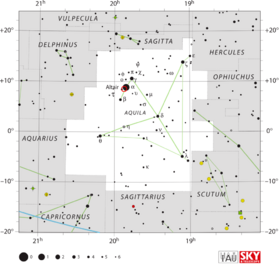Astronomy:V500 Aquilae
| Observation data Epoch J2000.0 Equinox (celestial coordinates) | |
|---|---|
| Constellation | Aquila |
| Right ascension | 19h 52m 27.84s[1] |
| Declination | +08° 28′ 46.4″[1] |
| Apparent magnitude (V) | 6.1 - 17.8p[2] |
| Astrometry | |
| Distance | 4900[3] pc |
| Characteristics | |
| Variable type | classical nova, eclipsing binary |
| Other designations | |
Nova Aquilae 1943, AAVSO 1947+08 | |
| Database references | |
| SIMBAD | data |
V500 Aquilae also known as Nova Aquilae 1943 was a nova which appeared in the constellation Aquila, very near the star Altair, in 1943. It was discovered by Cuno Hoffmeister on photographic plates taken at Sonneberg Observatory on 5 September 1943, when it had a photographic magnitude of 12.[4] It reached its peak brightness sometime between 13 April 1943 when it was fainter than photographic magnitude 13.5, and 2 May 1943 when its photographic magnitude was 6.55 (6.1 visual magnitude).[2]
V500 Aquilae's brightness dropped by 3 magnitudes from its peak in 42 days, making it a "fast" nova.[6]
All novae are binary stars, with a "donor" star orbiting a white dwarf. The two stars are so close to each other that matter is transferred from the donor to the white dwarf. Because the stars are separated by a distance comparable to the radius of the donor star, novae are often eclipsing binaries, and V500 Aquilae does show eclipses. The eclipses, first seen in 1994 at the European Southern Observatory, have a depth of about 0.4 magnitudes, and the orbital period is 3.485±0.02 h.[7]
In 1984 a small (radius 2.0 arc second) nova remnant surrounding V500 Aquilae and expanding at 1380 km/sec, was discovered using the Hale Telescope.[8] The expansion of that remnant has been used to derive a distance estimate of 4900 parsecs.[3]
References
- ↑ 1.0 1.1 Samus, N.N.; Goranskii, V.P.; Durlevich, O.V.; Zharova, A.V.; Kazarovets, E.V.; Kireeva, N.N.; Pastukhova, E.N.; Williams, D.B. et al. (July 2003). "An Electronic Version of the Second Volume of the General Catalogue of Variable Stars with Improved Coordinates". Astronomy Letters 29 (7): 468–479. doi:10.1134/1.1589864. Bibcode: 2003AstL...29..468S.
- ↑ 2.0 2.1 Duerbeck, Hilmar W. (March 1987). "A Reference Catalogue and Atlas of Galactic Novae". Space Science Reviews 45 (1–2): 1–14. doi:10.1007/BF00187826. Bibcode: 1987SSRv...45....1D.
- ↑ 3.0 3.1 Shafter, A.W. (September 1997). "On the Nova Rate in the Galaxy". The Astrophysical Journal 487 (1): 226–236. doi:10.1086/304609. Bibcode: 1997ApJ...487..226S.
- ↑ Kopff, August (9 September 1943). "Nova Aquilae". IAU Circular 961. http://www.cbat.eps.harvard.edu/IAUCs/IAUC0961.jpg. Retrieved 26 December 2020.
- ↑ Gaposchkin, Sergei (December 1943). "Photographic Light Curve of Nova Aquilae 1943". Harvard College Observatory Bulletin 917: 16–17. Bibcode: 1943BHarO.917R..16G. https://ui.adsabs.harvard.edu/abs/1943BHarO.917R..16G. Retrieved 28 October 2022.
- ↑ Payne-Gaposchkin, Cecilia (1 January 1957). The Galactic Novae. Amsterdam: North Holland Publishing Corp..
- ↑ Haefner, R. (14 May 1999). "V500 Aql: An Eclipsing Classical Nova". Information Bulletin on Variable Stars 4706 (4706): 1. Bibcode: 1999IBVS.4706....1H.
- ↑ Cohen, J.G. (May 1985). "Nova shells. II. Calibration of the distance scale using novae". The Astrophysical Journal 292: 90–103. doi:10.1086/163135. Bibcode: 1985ApJ...292...90C. https://authors.library.caltech.edu/95995/.
External links
 |



